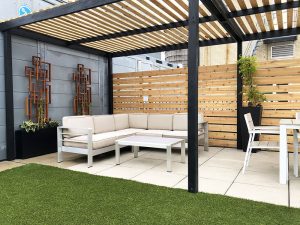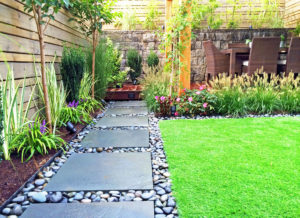
This week, let’s explore how to make a healing garden. With only a few exceptions, almost everything that you can grow in the ground can be grown in a container. Which means, as long as you have some time and space, you can have a healing garden in your own home. In my article about rooftop gardens, we learned about the Hanging Gardens of Babylon. These were the first container gardens, planted on top of stone columns. The vegetation would hang over the columns and in doing so would resemble “hanging gardens.” The next example of container gardening was in China around 200 A.D. with the popularization of bonsais. Bonsai leaves, branches and roots are pruned vigorously to keep their size small. They live in the same container for their whole life. Then, fast-forward to the 1660s, Europeans developed an interest in exotic plants. To meet this curiosity, many Europeans were growing pineapples and other tropical plants in containers in greenhouses. From there, container gardens have continued to grow in popularity over the years and have become a staple of urban gardening.
There are a lot of up-sides to container gardening. They’re great for beginners; if things don’t work out and the plants die, you can pull the plants, dump the soil and start anew. If a plant in a container garden gets a disease, like a fungus, or attracts a pest, then it is less likely to spread to all the other plants in the garden. Growing things in containers allows for portability. You can bring your plants indoors during cooler months to keep the plants alive throughout the entire year. Wildlife animals are less likely to dine on plants in your container garden and neighborhood pets off the leash are less likely to trample through a container garden. There are limitations, of course. The size of your growing space is restricted by the size of your container, which limits how much you can grow. Small-scale gardens also mean more frequent up-keep. Because the soil is limited to the size of the container, so is the moisture in the soil. This means you could find yourself having to water the plants more often. Frequent watering can potentially drain vital nutrients from the soil, so you may also have to fertilize plants in container gardens more often than you would ones planted in bare earth.
So, when starting to make your own healing garden in a container, there are a couple decisions you have to make. The first: do you want your garden to be inside or outside? The first question, of course, is do you have an outdoor space? Do you have a backyard, roof, fire escape or windowsill? Each are different environments with different yield capabilities. If you have a backyard and access to the ground, you can always garden sans container. But, containers allow for the ability to move your garden and design to your liking. Roofs are ideal because of their sunlight and because of the benefits discussed in last week’s article. Fire escapes are a wonderful alternative for people without other options, but be warned that in the state of New York (and in many other states), it is illegal to store things on your fire escape, and you might be fined. If you do decide to use your fire escape, be sure to keep a clear footpath for people to walk and make sure the handrails can still be used. Window boxes (whether actual boxes or cloth pouches) are a great outdoor alternative for people with no space. They’re easier to install than an air-conditioner, and you still get the benefits of growing outside. Outside containers need more regular watering than indoor containers due to their exposure to sun and air. If you want your garden to be inside, though, they require less watering but a little more attention. You have to be attentive to their environment and be sure they get enough sun. You also have to be more selective in your choice of what vessels to grow your plants in. You’re going to have to move them for deep waterings and want to make sure they’re mobile. You also probably will want focus a little more on aesthetics; it’s your home and you want it to look nice.
Once you decide if you want to grow inside or outside, you then should focus on irrigation. For inside growing, because of the more stable temperature and indirect sun, watering can be reduced, for most plants, to once or twice a week. Overwatering is a problem and can kill your plants. For outside, though, having a drip system attached to a hose tap or self-watering containers can really help with overall plant help. Drip irrigation produces healthier plants, better yields, and it is a great time saver. Because drip irrigation runs along the top of the soil, it also helps decrease the incidence of plant disease that can occur with the use of overhead sprinkler irrigation. Plus, many water-soluble fertilizers can be applied through the drip system, thereby keeping nutrients near the root zone and allowing the plants to get the most value from each fertilizer application. Below are some resources for setting up proper irrigation for plants.
-Irrigation Help: http://www.harmonyfarm.com/drip-irrigation-design/
-Here is a video of how to make your own self-watering container: https://youtu.be/nHZ4CLEGh-I
You can grow plants in almost anything, it just depends on what you’re growing and your personal aesthetic. There are a couple of important things to always keep in mind, though. Always make sure that the containers you’re using are food safe; meaning, free of carcinogens or other creepy things that will leech their way into the soil and, therefore, your beautiful garden. Also, make sure you’re always using organic, all-natural, food safe soil. This is the breeding ground for your garden, this is not a place to cut corners and get something that just works. Here are some options, listed from lightest to heaviest:

GROW BAGS: Also an economically and ecologically sound choice, grow bags are a great mode of growing inside and outside. The fabric helps the roots breathe, which helps prevent root rot and roots coiling in on themselves. They are very affordable, and you can purchase them in a wide variety of sizes and shapes. Be sure the pouch you buy though is food safe; some pouches are made from synthetic materials and might be unsafe. Also, make sure you have a barrier between your grow bag and your floors or walls, if using them inside. Because they are so porous, they can be messy.

.jpeg)
al growers to use. Plastic planters can come in an endless number of sizes and shapes. Lightweight and nearly indestructible, plastics have been the magic answer to a myriad of storage, transportation, and packaging dilemmas. But many plastics— particularly when they’re exposed to sunlight, water, and high temperatures—leach toxic chemicals like bisphenol A (or BPA), vinyl chloride, or phthalates which are hazardous to human health. Higher density plastics, such as those used to make yogurt pots, soda bottles, and rigid containers like cups, bowls, and planting pots are more stable, and therefore safer to use. Check the underside of containers to determine their suitability: numbers 1, 2, 4, and 5 are a good choice for planting edibles. Others are not.


Next week, what to grow for optimum healing, and each plants ideal growing environments …
Good books resources:
‘The Bountiful Container’, by Rose McGee and Maggie Stuckey
-After covering basics of soil, sun and water, fertilizer, seeds and propagation, this book then has a plant-by-plant raising and care guide. The container gardening bible.
‘The Essential Urban Gardener’ by Novella Carpenter and Willow Rosenthal
-practical blueprints and visual guides for gardeners of all levels and all sized spaces. A more city focused book than Bountiful Container with more of a focus on how to grow as opposed to what.
Good website resources:
http://www.bucolicbushwick.com/
-Woman living in Brooklyn who charts out all of her experiences of growing her roof garden, from composting to money spent to pests to containers used to crop yields. An awesome resource from a real New York resident with a budget
http://www.plantcaretoday.com
A great resource for learning how to grow Mandevilla Vines on Trellis and proper care.
Sources:
http://www.harmonyfarm.com/drip-irrigation-design/
http://www.urbanorganicgardener.com/gardens/nyc/fire-escape/
http://www.foodrenegade.com/container-gardening-for-urban-apartment-dwellers/
http://www.rodalesorganiclife.com/garden/are-your-plant-containers-leaching-toxins-your-food
https://extension.illinois.edu/containergardening/choosing_material.cfm
https://gardenerspath.com/how-to/containers/plant-containers-pots-planters-material-best/
http://site.outdora.com/blog/history-container-gardening-3849.html
http://www.offthegridnews.com/survival-gardening-2/8-advantages-to-container-gardening/
http://mrsmonk-myday.blogspot.com/2012/12/the-history-of-container-gardening.html









